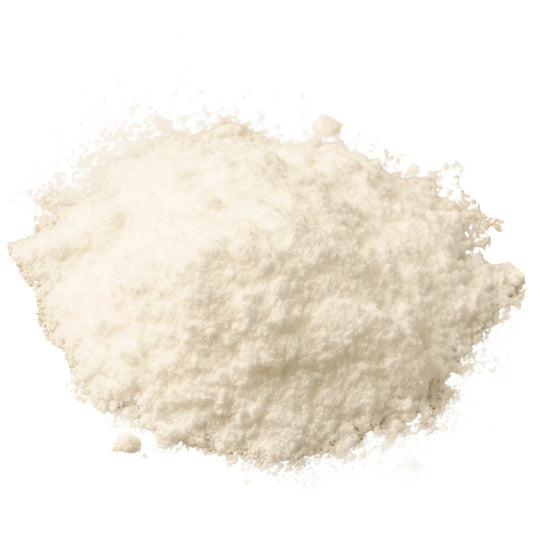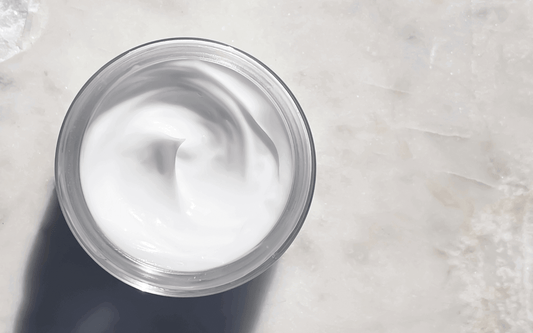
Formulating With Lecithin
Juliette van der MeerLecithin is a rather interesting ingredient. It has many uses, from emulsification to enhancing penetration of other ingredients, and more.
What is Lecithin?
Lecithin is a by-production of the oil extraction process, particularly from soy and sunflower oils. Lecithin is also naturally found in eggs - and that's why eggs can act as a binding or emulsifying agent in baking!
Why Use Lecithin?
Lecithin has emulsification properties, and is ultra-natural. It is simply a by-product of the oil extraction process and doesn't undergo any other modifications like most other emulsifiers do. So if you are into creating 100% natural, raw products, then lecithin may be a great choice.
Lecithin is also commonly found as an emulsifier in foods - its other name is E322.
Emulsifier and Co-emulsifier
Now, info on the internet is a bit sketchy for lecithin as a cosmetic emulsifier. Some say it is an oil-in-water emulsifier while others claim it is water-in-oil, others say it can be both. I agree with the last one, that it is both, although it can be a little tricky to work with.
Depending on the processing method, lecithin can create anything from thin O/W emulsions, which are ideal for serums, to much thicker W/O creams that are similar to body butters.
In the formulas later on in this blog, I have created two oil-in-water emulsions. They are lightweight and well absorbed, and they leave my skin wonderfully soft and moisturised for hours afterwards. I would highly recommend that you give lecithin a go!
More Properties of Lecithin
Besides being a versatile emulsifier, lecithin has a number of other properties.
- Due to its lipid content, it has a certain affiliation with the skin and can act as a penetration enhancer.
- It is classed as a phospholipid, which is a fancy term for a complex fat (lipid) that also contains phosphoric acids, a nitrogen base, alcohol and fatty acids, and has a molecular structure consisting of a single hydrophilic (water-loving) 'head' and two hydrophobic (water hating) tails'. These amphiphilic properties give lecithin its emulsification ability.
- Lecithin is a wonderful emollient and occlusive. That's right, you don't have to use it as an emulsifier. It can simply be added to products to boost the emollient and occlusive properties, thereby protecting the skin better. It is softening and replenishing, and leaves a wonderful, nourished skin feel.
Solubility
Lecithin is oil soluble. While it can be 'hydrated' and swell to an extent, it won't naturally mix with water unless processed in a specific way.
Skin Feel & Organoleptic Properties
Lecithin yields creamy and rich feeling products. I find it leaves a lovely smooth, silky and luxurious feel on the skin.
- It is not a thickening wax like most emulsifiers. Lecithin won't contribute any viscosity to an emulsion so you need to control that with fatty acids, butters and other viscosity modifiers.
- It tends to have a nutty scent, and is typically a deep caramel or brown colour. Keep this in mind when formulating as these properties can come through in the final product.
What Can You Make With Lecithin?
Lecithin can be used in all kinds of creams, moisturisers and emulsion serums. Since it has emulsifying properties it can be used in all kinds of emulsions, although it does create a richer feeling product so you'll want to only use it in products where that sort of feel is required. You can use it as a stand alone emulsifier or as a co-emulsifier. I particularly enjoy it as a co-emulsifier!
You can also add it to anhydrous (oil-only) products. Try it in a lip balm for a lux skin-feel.
I really like a small amount of lecithin in any night moisturiser. It adds a touch of occlusivity and rich emolliency that really gives a nice feel. It also acts as a penetration enhancer, which is desirable if you have other actives. I use it at 0.5% for its penetration enhancing properties.
Lecithin Usage Rate
0.5 - 10%
0.5% as a penetration enhancer.
0.5-2% as a co-emulsifier.
2-10% as a sole emulsifier.
Note: Add lecithin to the heated oil phase of a formula.How To Work With Lecithin
Making stable emulsions with lecithin as the sole emulsifier can be tricky but is doable with a little patience.
- The great secret is to drizzle in the water and oil parts veerrryyy slowly. So it's not like combining phases in a normal emulsion; lecithin takes a little more time and patience.
- You also require heat - so make sure your phases are sufficiently hot and at similar temperatures to one another.
- Lastly you need high shear. Please don't mix by hand or with an electric beater. You need to use a stick/soup blender.
Lecithin Plays Well With
Lecithin likes oils and oil based products. It also works really well with lanolin.
It is great with oil soluble actives. Think Vitamin A, Vitamin E, ascorbyl palmitate, bisabolol, Co Enzyme Q10 etc.
Formulas Using Lecithin As The Emulsifier
Here are two O/W emulsions made using lecithin as the sole emulsifier.
The first is a thin emulsion serum, and the second has more of a classic moisturiser consistency. This demonstrations how versatile lecithin is!
I haven't provided a W/O emulsion as they are difficult to create (and also I don't really enjoy W/O emulsions as I find them too greasy!).
Lecithin Emulsion Serum
I'm showing you one way to process lecithin, by 'hydrating' it. This formula creates a lovely lightweight emulsion serum.
Ingredients:
Phase A
- 3% lecithin
- 6% water, freshly boiled
- 15% safflower oil, or another lightweight oil such as almond, apricot etc
Phase B
- 4% glycerine
- 0.4% xanthan gum
- 70.6% water
Phase C / Cool down
- 1% preservative - I used Euxyl 9010
Equipment
- Soup/stick blender
- Beakers
- Spatula spoon
Method:
- Hydrate the lecithin and 6% boiled water by stirring the two together in a beaker for 30 minutes. Like I said, working with lecithin requires patience!
- While the lecithin is hydrating, mix the xanthan gum and glycerine together in a beaker to create a slurry, then add the water and blend to create a gel.
- Once the lecithin has hydrated, trickle in the oil a few drops at a time, homogenising with the blender between each addition. Do not add it all at once or it will overwhelm the lecithin.
- Now you have one beaker with oil and lecithin, and one with gel. Bring both up to 70 degrees, then trickle the lecithin mixture into the water mixture, homogenising as you go. Lastly, add in preservative once the emulsion has cooled below 35 degrees.
- Check and adjust pH if required.
- Pour into a serum bottle and enjoy!

















6 comments
Hi there Bettina,
Thank you for the question!
This can be challenging because Animals (like us) are sensitive to taste. A few animal friendly work-arounds could be:
1. Use Natural Sweeteners
Apple Juice (Unsweetened): A small amount can mask bitterness and is generally safe for most animals in moderation (though do check with a vet for your specific animal, as we ourselves are not vets).
Honey (for Dogs): A small amount of raw honey can sweeten the mix and is safe for dogs, but avoid for cats or if the animal has diabetes.
Stevia (Animal-Safe): Opt for pure, unsweetened stevia extract without additives. Use sparingly to avoid overwhelming the taste (as Stevia is really, surprisingly sweet – I was shocked the first time I had it :)
2. Add Flavor Enhancers
Bone Broth (for Dogs and Cats): Mix in a small amount of plain, unsalted bone broth for a flavour that animals love.
Tuna Water (for Cats): For finicky cats, adding a little water from unsalted, canned tuna can make it more appealing.
Chicken or Beef Broth: Use a low-sodium, pet-safe broth to improve the palatability.
3. Dilute for Better Taste
Mix the liposomal Vitamin C with more water to dilute the bitterness. Offer it in a larger volume if the animal tolerates liquid well.
4. Serve with Familiar Foods
For Dogs and Cats: Add the mixture to wet food or a small treat they already enjoy.
For Horses: Mix it with molasses, applesauce, or oats.
5. Use Encapsulation or Alternatives
If the above options fail, consider encapsulating the Vitamin C mixture in pet-safe capsules, making it easier to administer without relying on taste.
We hope that helps.
Kindest Regards,
Essentially Natural Support
Have you got any recommendations to improve the taste for the DIY liposomal Vit C with liquid lecithin ? It is used for animals
Regards
bettina
Hi there Marian,
Yes, Soy Lecithin can be used to make your own liposomal Vitamin C :)
Ingredients:
- Food Grade Vitamin C : 2%
- Food Grade Soy Lecithin : 6%
- Distilled Water : 91%
- A small amount of Baking Soda (in case you would need to adjust the pH)
- Potassium Sorbate and Sodium Benzoate : 1%
You would also need a high speed blender, measuring spoons and a glass container.
Instructions:
1. Prepare the ingredients:
If you’re using ascorbic acid, you may want to adjust the pH. Mix a pinch of baking soda in a small amount of water and add it to the Vitamin C mixture. This helps neutralize the acidity and can improve absorption.
In your blender, combine the Vitamin C powder with distilled water. Blend for about 30 seconds to dissolve the Vitamin C completely. Make sure the powder is well dissolved before moving to the next step.
2. Add the lecithin:
Add the soy lecithin to the blender with the Vitamin C solution.
Blend for about 1-2 minutes on high speed. The lecithin will help form tiny bubbles (liposomes) around the Vitamin C molecules.
3. Create the liposomes:
For best results, you’ll want to ultrasonicate the mixture. An ultrasonic cleaner (used for liposome production) can help break the mixture down into even smaller particles, ensuring proper liposomal formation. If you don’t have an ultrasonic cleaner, a high-speed blender should suffice. Blend for an additional 2-3 minutes to further break down the lecithin and create small, uniform liposomes.
4. Add Preservatives:
After the mixture has cooled down (ensure it’s under 40°C), add Potassium Sorbate and Sodium Benzoate. Both of these preservatives work together to prevent microbial growth and extend the shelf life.
5. Store the liposomal Vitamin C:
Transfer the mixture into a dark glass container to protect it from light.
Always shake gently before using to ensure the liposomes remain stable.
5. Dosage & Use:
Take 1-2 teaspoons daily. It can be taken directly or mixed with water or juice.
We hope that helps :)
Kindest Regards,
Essentially Natural Support
Please advise whether soy lecithin can be used to make my own liposomal Vitamin C. Thank you.
Hi Ida, yes please follow this link:
https://essentiallynatural.co.za/blogs/quick-guides/working-with-percentages